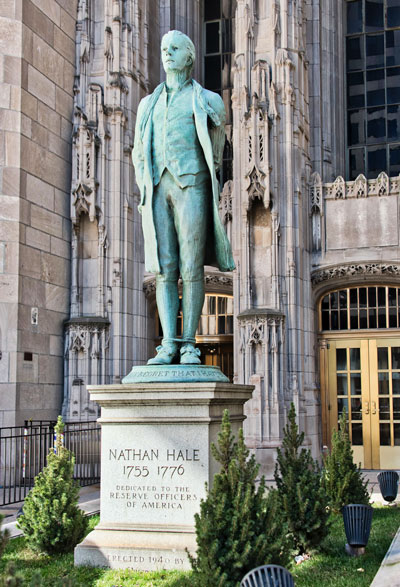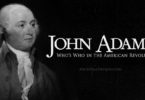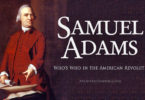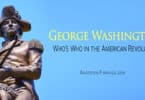“I regret that I have but one life to give for my country.”
These famous words belonged to a young Revolutionary patriot named Nathan Hale, and they are famous even today, more than two centuries later. But, who exactly was Nathan Hale, beyond his historically famous declaration? Nathan Hale may be among the most quotable revolutionaries, but there was so much more to him than this one sentence, given during this one moment in time during the Revolution. He is a man worth getting to know better. Here is his story.
Nathan Hale (June 6, 1755 – September 22, 1776) was an American soldier and spy for the Americans during the American Revolution. He was born in Coventry, Connecticut to parents Richard Hale and Elizabeth Strong. His family was among the local elite, evidenced by the fact that he was sent to Yale when he was fourteen (a brother, Enoch, who was sixteen, was sent to Yale at the same time as Nathan). Only children of elite, usually meaning wealthy and/or influential families went to Harvard and Yale in the 18th century in America, both before and after the Revolution.
Nathan had an impressive career at Yale, where he was classmates with a future fellow patriot spy named Benjamin Tallmadge. Nathan and Enoch were members of the Linonian Society at Yale, which was a group that got together to debate things in such wildly diverse topics as astronomy, literature, math, and ethics (particularly the ethics of slavery, a popular topic of discussion among the New England elite at the time). Nathan graduated with honors when he was eighteen, and began a career as a teacher, first teaching in East Haddam, Connecticut, and then later in New London, Connecticut.
By the time he had been teaching for a couple of years, the American Revolution began, and he volunteered to be part of a Connecticut militia. He performed so well in this role that he was promoted to 1st lieutenant in his first five months of service. His regiment was part of the American contingent that fought in the Siege of Boston, though Hale was not part of the fighting, due to his teaching contract still being active at the time. It kept him in the classroom and from joining his regiment on the battlefield until it ran out a few months later.
Hale’s friend and former Yale classmate, Benjamin Tallmadge, did not participate in the siege, either, but he saw it. After witnessing the siege firsthand, he wrote to Hale. His letter stated Tallmadge’s opinion about military service for the American cause. One part Hale found particularly inspiring said:
“Was I in your condition, I think the more extensive service would be my choice. Our holy Religion, the honor of our God, a glorious country, and a happy constitution is what we have to defend.”
It was this letter from Tallmadge that inspired Hale to accept the commission as the 1st lieutenant when it was offered to him. He served in this role in the Seventh Connecticut Regiment, with Colonel Charles Webb of Stamford as its commander.
The next spring, Hale’s regiment moved to Manhattan to help the effort of keeping the British from gaining control of New York City. By that fall, George Washington knew a British invasion of Manhattan was inevitable but didn’t know exactly when they would begin it. He needed a spy to get the information, so the Americans could make better preparations to protect the city. The spy would have to go behind enemy lines and pretend to be one of them. When Washington made the call was made for volunteers for this job, Nathan Hale was the only one in the Continental Army serving in Manhattan at the time to answer it. Thus began his career as a revolutionary spy.
The act of spying was inherently dangerous, as the British had a policy of executing anyone captured as a spy on the American side. Just volunteering for this mission was an act of supreme bravery on Hale’s part, and also likely explains why no one else volunteered to do it. Hale didn’t get the chance to do much spying, as the British invaded New York City and captured it soon after American troops ferried Hale over to the British side of the Hudson River. Washington and his troops were forced to retreat to Harlem Heights. Not long after, a quarter of Manhattan was burned down, though the fire was thought to have been started by Americans to keep the city from falling into the hands of the British. Washington and the Continental Congress denied this, and others thought it was the work of British soldiers acting without orders. At any rate, more than 200 American soldiers and sympathizers were captured by the British after the fire destroyed part of Manhattan.
Hale was among those captured. A British soldier saw Hale in a tavern and recognized him as an American soldier he’d met before, despite Hale’s disguise. The soldier, Major Robert Rogers, pretended to be a patriot to get Hale to reveal himself, which Hale did. Hale was apprehended near Flushing Bay in Queens, and taken to the home of British General William Howe at the Beekman House in rural Manhattan. Howe reportedly questioned Hale, and physical evidence of his spying was found on him. Rogers, the man who lured him into giving away his identity, also provided evidence in the case against Hale.
After the questioning, Hale (traditionally) spent the night in a greenhouse at Beekman House, and requested both a Bible and a clergyman, though both requests were denied. According to British military standards at the time, spies were to be hanged as illegal combatants. Hale volunteered for the spy mission on September 8, 1776. He was discovered by the British and hanged as a spy on September 22, 1776. He was 21 years old at the time he was hanged.
All accounts of Hale’s walk to the gallows and the speech he gave upon it indicate he was calm and serene, focused and clear in what he had to say. Before the hanging, he asked for and was given pen and paper, which he used to write a letter to his mother, and to a fellow soldier. The exact site of his execution is not known, but four places in Manhattan today claim that distinction. His body was never recovered by his family afterward, and no one knows what the British did with it. Hale’s family erected a cenotaph (memorial with nobody in or under it) to him in what would become the Nathan Hale Cemetery in South Coventry, Connecticut, now a historic district. In 1985, Nathan Hale was officially given the title of State Hero of Connecticut.







